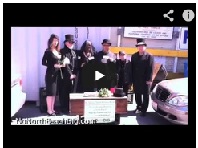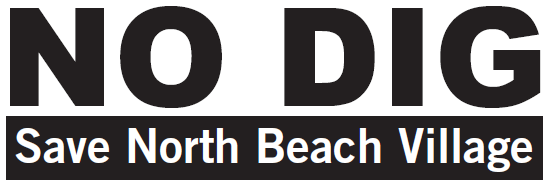What is the Pagoda Option?
Below are two explanations of the North Beach Variant, currently called the Pagoda Option.
The first version is a straightforward presentation of the facts and history of the project.
The second version is a light-hearted treatment. As you become more familiar with Muni and the project, it's likely you'll find this version closer to reality.
Contents |
The North Beach Variant (Pagoda Option)
The North Beach Variant extension to the Central Subway came about during the final stages of the design by the San Francisco Municipal Transportation Agency (Muni). The original plans called for the subway to end at Chinatown, but citizen groups objected and insisted that there be a promise of an eventual extension to North Beach and Fisherman's Wharf. As a result the North Beach Variant was added to the plan, the citizen groups removed their objections, and the Central Subway project was approved in 2008.
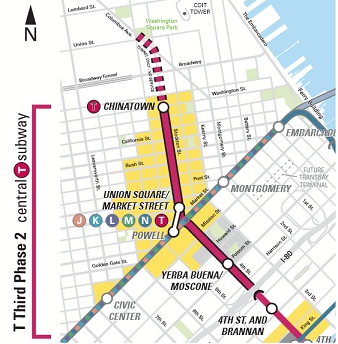
|
| Map of Central Subway and Pagoda Option (broken line at top) |
The North Beach Variant originally consisted of two "storage tunnels." Once these tunnels are completed Muni plans to extract the tunnel boring machines (TBMs) in North Beach. This would require an extraction shaft dug down a little over 40 feet to reach the tunnels and the machines. (Note that the usual way of dealing with TBMs is to bury them — see below.) Though Muni says it will fill in the extraction shaft after the TBMs are removed, it's likely the shaft will remain open for several more years as an access to facilitate the Chinatown station construction.
The unhappy part of this scheme is that the boring machines will emerge in the heart of San Francisco's Little Italy, and next to one of the City's prettiest parks. Visitors to this neighborhood enjoy outdoor dining, sitting in Beatnik-era coffee houses, and strolling along streets lined with family-owned businesses.
Naturally, residents and businesses here don't want the area to be the "corporation yard" for the Central Subway. In this David vs Goliath tale, Muni has ignored the locals and is determined to bore tunnels where trains might never run and to dig a huge shaft to pull out the boring machines. What do local folks get for two to ten years of digging, dust, and dirt? A subway station? No. Something needed for the success of the Central Subway? No. What then? Well, they get the "shaft."
If you're interested in knowing more about the unneeded North Beach Variant (Pagoda Option), which will cost $70 million in Federal funds plus $9 million in local funds, read on.
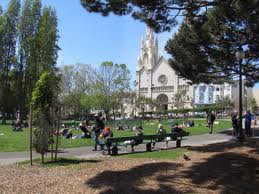
|
| Washington Square Park |
Muni determined to extract TBMs
On any other tunneling project engineers would bury or remove the boring machines at the end of the line. But Muni is determined to tunnel an additional 2,100 feet into North Beach to extract the TBMs.
Most tunnel engineers disagree with this approach. In an article called "Central Subway: Muni's Drilling Plan Strains Credulity" by Joe Eskenazi in SF Weekly, he writes:
The concept of digging an additional few thousand feet for the sake of extracting boring machines puzzled experienced engineers. "It's surprising to me it would be worth taking them out," says Douglas Hamilton, the engineering geologist for the Devil's Slide project. Why not, he asks, simply mothball the machines at a point in Chinatown past where future trains will go? Why not bury them beneath the right-of-way? Or why not scrap them and haul out the pieces the way they came in?
Muni is determined to spend nearly $80 million dollars to extract two machines with a combined salvage value of about $5 million.
The Mid-Columbus Option
A North Beach location was chosen to be the terminus of the tunnels and the point where the TBMs would be extracted. This was the "Mid-Columbus Option," on Columbus Avenue just north of Union Street. The 50' by 50' extraction shaft would span the width of this heavily traveled avenue.
When it was announced in Auguat 2012 that construction of the excavation shaft would begin, local merchants filed suit to stop it, claiming that shutting down traffic on Columbus Avenue would hurt business.
Muni then held a series of meetings with the North Beach neighborhood to determine an alternative extraction site. At one meeting attendees were given a choice of four alternate sites. A majority chose the alternative that would bury or extract TBMs at the Chinatown station site, the "Chinatown Option."
The Pagoda Option
At subsequent neighborhood meetings, the "Chinatown Option" never appeared again. Muni instead presented the Pagoda Theater site (the "Pagoda Option"), just a few hundred feet west of the Mid-Columbus site, as the place where the extraction shaft would be dug.
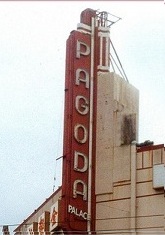
|
The "Pagoda Option" gets its name from the Pagoda Theater, a now-dilapidated shell of an old neighborhood theater in North Beach. It stands just across from the jewel of the neighborhood, Washington Square Park.
During roughly two months from late 2012 to early 2013, Muni scrambled to get permits, environmental clearances, and funding in place to lease and use the Pagoda Theater site. This process would normally take about six months.
The Pagoda Option would cost about $9 million more than the Mid-Columbus Option since the old Pagoda Theater would have to be leased for two years from the owner, and demolished. The Pagoda site owner would receive $3.15 million dollars for lease and use, pushing the North Beach Variant cost to $70 million in federal money plus more than $9 million in local bus funds.
Pagoda site problems
Like many areas in this part of San Francisco the soil under buildings is silt, clay and sand mixed with rubble from the Great Earthquake and Fire of 1906, with underground streams flowing to the Bay. In other words, it's the last place you would want to dig a 50' x 50' by 42' deep hole with other buildings nearby --- their foundations would very likely weaken due to the hole. It's a little like digging a hole in the sand at the beach near the waterline --- if you're standing near the edge of the hole, eventually the sides give way and you're pulled in.
In the year 2000 a project was begun to remodel the old theater into a dinner theater venue. However, this project ended after about two years because of serious and expensive foundation problems due to a high ground water table, that is, a stream running just beneath the ground.
A well-known geotechnical engineer, Lawrence Karp, surveyed the Pagoda site and you can review his reports. The method proposed for construction at the site is called "compensation grouting" but this might introduce a new set of problems.
Why not use the Chinatown Option and dispose of the TBMs there?
This question arose a number of times at neighborhood meetings with Muni. In all instances Muni stonewalled the questioners and gave weak rationales as to why the Pagoda Option was the only viable alternative.

|
| Tunnel boring machine 22 feet in diameter, 36 feet long |
It's interesting to note how the North Beach Variant evolved from (1) storage tunnels to (2) tunnels with an extraction shaft to (3) tunnels with an extraction shaft that requires demolition of a building at an additional $9 million cost. And all of this to remove two used-up machines with a salvage value of about $5 million.
Of course this doesn't make any sense. One explanation is that Muni intends to use the extraction shaft as an access point to build the Chinatown station, since the Stockton & Washington Streets location can't accommodate large trucks and other construction needs. This would leave the hole at the Pagoda site open for the remaining six years of the Central Subway construction, with trucks and cranes delivering and removing materials.
Muni denies this and says it will fill in the extraction shaft after removing the TBMs, about two years out.
You be the judge.
Where the Pagoda Option stands now (Spring 2013)
The lease for the Pagoda site has been signed but will not be effective until all approvals are in place. One final item is an OK from the FTA national office to accept the Supplemental Environmental Impact Report for the Pagoda site. In early May Muni put out a call for bids to demolish the Pagoda Theater.
All this is occurring at a time when Muni has a long-standing deficit of $70 million, and the Central Subway is projected to have a $400 million overrun by the 2018 completion date. In addition, the Muni system will be underfunded over the next 20 years. Spending $70 to $80 million for the Pagoda Option doesn't make sense, especially with the Chinatown Option as a low-cost alternative.
There has been steady opposition to the North Beach Variant, both the Mid-Columbus and Pagoda Options. Residents are not willing to endure years of excavation, dust, noise, thousands of truck trips through the neighborhood, business hardships, and more, with no foreseeable benefit. A North Beach subway station is at least 15–20 years from becoming a reality, assuming residents decide a subway station is the best transit alternative for the area.
The Pagoda Option (Light-hearted version)

|
Is "The Pagoda Option" a newly-discovered Robert Ludlum spy novel? Hardly. It's more like a harebrained scheme cooked up by Wile E. Coyote --- elaborate, expensive, and doomed not to work.
The Pagoda Option is a clever idea dreamed up by the San Francisco transit agency, Muni, to dig a couple of extra train tunnels past the end of the line of its Central Subway project. The purpose of these two 1/2-mile long tunnels is to remove Tasmanian Devil-like tunnel boring machines. Since the tunnels are more than 40 feet below the ground Muni will also have to dig an "extraction shaft" to lift the machines out.
On any other tunneling project engineers would remove the boring machines at the end of the line. But you can imagine the glazed look in Muni's or Wile E. Coyote's eyes as they confidently bore an extra 1/2 mile of tunnels --- for nothing.

|
| Washington Square Park |
The unhappy part of this scheme is that the boring machines will emerge in the heart of San Francisco's Little Italy, and next to one of the City's prettiest parks. Visitors to this neighborhood enjoy outdoor dining, sitting in Beatnik-era coffee houses, and strolling along streets lined with family-owned businesses.
Naturally, residents and businesses here don't want the area to be the "corporation yard" for the Central Subway. In this David vs Goliath tale, Muni has ignored the locals and is determined to bore tunnels where trains might never run and to dig a huge shaft to pull out the boring machines. What do local folks get for two to ten years of digging, dust, and dirt? A subway station? No. Something needed for the success of the Central Subway? No. What then? Well, they get the "shaft."
If you're interested in knowing more about the unneeded Pagoda Option, which will cost $70 million in Federal funds plus $9 million in local funds, read on. The Looney Tunes cartoonists might even find this story too far-fetched.
The Pagoda Theater

|
The "Pagoda Option" gets its name from the Pagoda Theater, a now-dilapidated shell of an old neighborhood theater in North Beach. It stands just across from the jewel of the neighborhood, Washington Square Park.
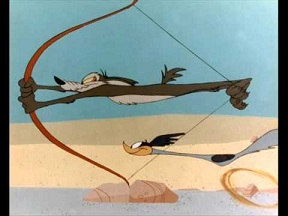
|
This site is about two hundred feet from the original boring machine extraction site chosen by Muni, the "Mid-Columbus Option." This was named for the main artery of North Beach, Columbus Avenue. The entire width of this broad avenue was slated to be the site of the extraction shaft.
After local business people told Muni their site choice wasn't going to work, because the traffic stoppage on Columbus Avenue would kill their businesses, Muni scrambled to get permits, EIRs, and funding in place to lease and use the Pagoda Theater site just a few hundred feet away.
Note the key word "scramble." Recall that a number of Wile E. Coyote's schemes to catch the Road Runner involved, for example, having a giant bird cage open and in the middle of the road just in time to catch the bird as he ran by. Similarly, Muni has to have their extraction shaft in place so they can remove the tunnel boring machines when they finish the tunnels. If the extraction shaft is delayed and the machines have to wait in the ground too long, their innards rot and they have no resale value after they are extracted.
Slip-and-slide soil

|
| Map of Central Subway and Pagoda Option (broken line at top) |
"Whew," Muni must have sighed when the alternate site was secured at the Pagoda Theater. Now they would have a place to dig a hole to pull out the Tasmanian Devil boring machines. But little did they know that now their problems were even more challenging. It's a little like Mr. Coyote jumping out of the way of a huge truck on the highway and landing in a pit of quicksand.
Like many areas in this part of San Francisco the soil under buildings is silt, clay and sand mixed with rubble from the Great Earthquake and Fire of 1906, with underground streams flowing to the Bay. In other words, the last place you would want to dig a 50' x 50' by 42' deep hole with other buildings nearby --- their foundations would very likely weaken due to the hole. It's a little like digging a hole in the sand at the beach near the waterline --- if you're standing near the edge of the hole, eventually the sides give way and you're pulled in.
A well-known geotechnical engineer, Lawrence Karp, surveyed the Pagoda site and you can review his reports. The method proposed for construction at the site is called "compensation grouting" but this might introduce a new set of problems.
Oh yeah, the money
Muni began hastily looking for funds to switch to the Pagoda Option from the Mid-Columbus Option, which was going to cost to a little over $9 million extra. Since they are a bus company what better place than to siphon off a few million from the existing bus and train operating funds. Never mind that these buses and trains are already desperately in need of repairs and maintenance, the subway is the future of San Francisco!
See more about cost overruns.
Undaunted, Muni marches on
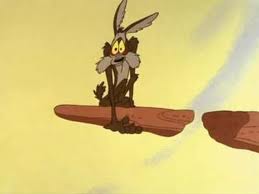
|
Mr. Wile E. Coyote, in his zeal to catch the Road Runner, often found himself standing on a thin piece of rock sticking out of a ledge, with the canyon floor hundreds of feet below. As he looks back and sees cracks form in the outcropping, beads of sweat begin to pop off his brow. We all know what happens next.
Muni is now in a similar position: contractors are debating whether or not to dig at the sloshy Pagoda site, and the funding and budgetary problems are mounting. Like Wile E. Coyote, Muni is confident it can overcome anything with its vast engineering, finance, and PR teams, and hopes the rock it's standing on with all the cracks in it will hold. But we all know what happens next.
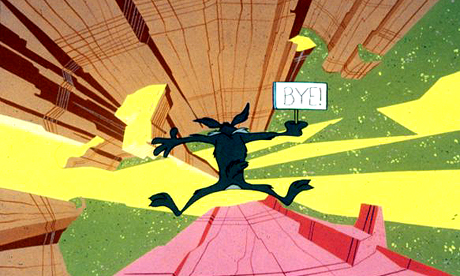
|
(Note: It's perhaps unfair to compare Muni to Wile E. Coyote. Our
apologies to Mr. Coyote.)
Looney Tunes: Looney Tunes, characters, names and all related indicia are trademarks of and © 2001 Warner Bros.
